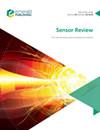A multi-sensor based emergency healthcare monitoring system integrating heart status, stress, and alcohol detections
IF 1.4
4区 工程技术
Q3 INSTRUMENTS & INSTRUMENTATION
引用次数: 0
Abstract
Purpose Ubiquitous health-care monitoring systems can provide continuous surveillance to a person using various sensors, including wearables and implantable and fabric-woven sensors. By assessing the state of many physiological characteristics of the patient’s body, continuous monitoring can assist in preparing for the impending emergency. To address this issue, this study aims to propose a health-care system that integrates the treatment of the impending heart, stress and alcohol emergencies. For this purpose, this study uses readings from sensors used for electrocardiography, heart rate, respiration rate, blood alcohol content percentage and blood pressure of a patient’s body. Design/methodology/approach For heart status, stress level and alcohol detection, the parametric values obtained from these sensors are preprocessed and further divided into four, five and six phases, respectively. A final integrated emergency stage is derived from the stages that were interpreted to examine at a person’s state of emergency. A thorough analysis of the proposed model is carried out using four classification techniques, including decision trees, support vector machines, k nearest neighbors and ensemble classifiers. For all of the aforementioned detections, four metrics are used to evaluate performance: classification accuracy, precision, recall and fmeasure. Findings Eventually, results are validated against the existing health-care systems. The empirical results received reveal that the proposed model outperforms the existing health-care models in the context of metrics above for different detections taken into consideration. Originality/value This study proposes a health-care system capable of performing data processing using wearable sensors. It is of great importance for real-time systems. This study assures the originality of the proposed system.一个基于多传感器的紧急医疗监测系统,集成了心脏状态、压力和酒精检测
目的无处不在的医疗保健监测系统可以使用各种传感器为人们提供持续的监测,包括可穿戴设备、植入式和织物编织传感器。通过评估患者身体的许多生理特征的状态,持续监测可以帮助为即将到来的紧急情况做好准备。为了解决这个问题,本研究旨在提出一个医疗保健系统,将即将到来的心脏、压力和酒精紧急情况的治疗结合起来。为此,这项研究使用了用于心电图、心率、呼吸率、血液酒精含量百分比和患者身体血压的传感器读数。设计/方法/方法对于心脏状态、压力水平和酒精检测,从这些传感器获得的参数值被预处理,并分别进一步分为四个、五个和六个阶段。最后的综合应急阶段是从被解释为在个人紧急状态下进行检查的阶段派生出来的。使用四种分类技术,包括决策树、支持向量机、k近邻和集成分类器,对所提出的模型进行了深入分析。对于上述所有检测,使用四个指标来评估性能:分类准确性、精确度、召回率和fmeasure。结果最终,将结果与现有的医疗保健系统进行对比验证。收到的经验结果表明,在考虑不同检测的上述指标的背景下,所提出的模型优于现有的医疗保健模型。独创性/价值这项研究提出了一种能够使用可穿戴传感器进行数据处理的医疗保健系统。它对实时系统具有重要意义。这项研究确保了所提出的系统的独创性。
本文章由计算机程序翻译,如有差异,请以英文原文为准。
求助全文
约1分钟内获得全文
求助全文
来源期刊

Sensor Review
工程技术-仪器仪表
CiteScore
3.40
自引率
6.20%
发文量
50
审稿时长
3.7 months
期刊介绍:
Sensor Review publishes peer reviewed state-of-the-art articles and specially commissioned technology reviews. Each issue of this multidisciplinary journal includes high quality original content covering all aspects of sensors and their applications, and reflecting the most interesting and strategically important research and development activities from around the world. Because of this, readers can stay at the very forefront of high technology sensor developments.
Emphasis is placed on detailed independent regular and review articles identifying the full range of sensors currently available for specific applications, as well as highlighting those areas of technology showing great potential for the future. The journal encourages authors to consider the practical and social implications of their articles.
All articles undergo a rigorous double-blind peer review process which involves an initial assessment of suitability of an article for the journal followed by sending it to, at least two reviewers in the field if deemed suitable.
Sensor Review’s coverage includes, but is not restricted to:
Mechanical sensors – position, displacement, proximity, velocity, acceleration, vibration, force, torque, pressure, and flow sensors
Electric and magnetic sensors – resistance, inductive, capacitive, piezoelectric, eddy-current, electromagnetic, photoelectric, and thermoelectric sensors
Temperature sensors, infrared sensors, humidity sensors
Optical, electro-optical and fibre-optic sensors and systems, photonic sensors
Biosensors, wearable and implantable sensors and systems, immunosensors
Gas and chemical sensors and systems, polymer sensors
Acoustic and ultrasonic sensors
Haptic sensors and devices
Smart and intelligent sensors and systems
Nanosensors, NEMS, MEMS, and BioMEMS
Quantum sensors
Sensor systems: sensor data fusion, signals, processing and interfacing, signal conditioning.
 求助内容:
求助内容: 应助结果提醒方式:
应助结果提醒方式:


